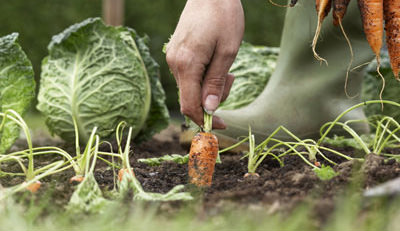
The fall can be one of the most enjoyable and easiest times to grow vegetables—if you can make it out of the summer. With heat, aggressive weed seeds and pests still lingering around your fresh, tender greens, there can certainly be some challenges to establishing a fall garden. But with a few simple techniques, you can avoid fall crop failure and have beautiful greens and brassicas well into the first frosts.
1. Start Crops Earlier
Don’t forget, unlike the spring when the daylight is increasing, fall days become shorter after the summer solstice. So it is critical for your fall garden that you allow extra time for plants to mature. This will vary from area to area, but my general rule of thumb is that I add at least 10 days to maturity for each crop. So a 90-day crop will take at least 100 days, a 50-day crop will take at least 60 and so on. It’s OK to be even more cautious. In the fall, when temperatures are cooler, things such as broccoli will be much slower to bolt, and you’ve much less reason to worry about them maturing early. Better to get them in early and have to hold on to them than to get them in late and lose them to cold snaps, or worse, have them not mature at all.
2. Stale Seed Bed Like Crazy
When you get your soil ready for the fall garden, start as early as possible. In fact, start in the spring if you can, when cool weather crops are still germinating. I recommend employing all manner of cultivation technique before you plant. Start with allowing the weeds to germinate, use a large black tarp if you have one for occultation it, and run a wheel hoe through. Whatever you can do to ensure the weed pressure is down will increase your yields in the fall but also your ability to get back into that ground early in the spring.
3. Be Prepared to Cultivate More
If you do a decent job of stale seed bedding and pre-emergent cultivation, there is still one thing to consider for the fall garden: cool weather weeds. The earth does its best to cover itself every fall with a different flush of things such as wild onions, henbit and chickweed, so be prepared to battle a few of latecomers as temperatures and daylight drop.
4. Manage Moisture
If August and September are generally dry in your region as they are here in Kentucky, you will need to consider your moisture in establishing a fall garden. To beat pests and disease, fall crops will need some help getting established. Irrigation is the best way to do this, but moisture can also be managed through biodegradable plastic or organic mulches such as straw and hay. When germinating seeds such as carrots that take several days, I recommend using row cover, which will allow for better moisture retention over the entire bed.
5. Use Insect Netting
Harlequin beetles are the pest that come to mind most for me in terms of crops in the fall garden. They are ravenous brassica fanatics and tend to not only leave crops looking skeletal but also spread disease. Cover up young plants with insect netting in their early days at least to get them established. If you are planting a fruiting crop such as a late summer squash, for instance, uncover it when you see flowers to allow for pollination.
6. Plant At Night
You want your crops to have the best chance possible to get established. For me, the best way to do that is to plant later in the evening and let the plants take hold overnight. Doing this right before a cool or cloudy day is even better. Crops generally take about three days to recover from the transplant and get some good roots into the soil. Allow for that to be as gentle as summer temps will allow––use shade cloth, irrigation and any other tool at your disposal.
7. Use Summer Cover Crops
If it’s nearing the fall where you are like it is for us, you probably don’t have time to sneak a summer cover crop into your fall garden, but we find that having a summer cover crop before the fall garden really helps with moisture retention and overall plant performance. So if nothing else, make sure to plan a summer cover crop or two—buckwheat is quick, and Sudan grass is substantial—before you start preparing the soil. This is not essential, but it could pay off big in terms of yield.




